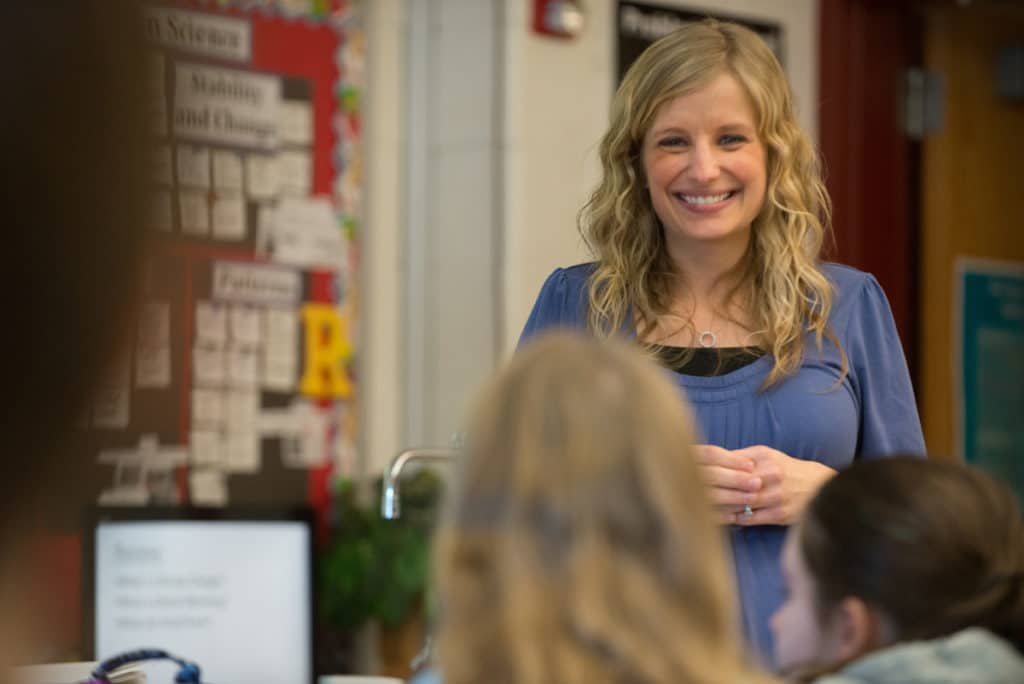
“We used to have pictures like these going back for years,” says Peter Harrison, principal of Young School, indicating a pair of large framed photos by the school’s entrance. Each picture shows about 300 children and forty adults gathered outside the compact modular building that now houses this K–2 school.
All the pictures from earlier in Young’s fifty-year history were lost three years ago, when concerns about air quality in the school led to testing that revealed serious mold contamination. The building was condemned, and all porous materials inside it were destroyed, including furnishings, lesson plans, student records, art supplies, musical instruments, and thousands of books. Some of the faculty lost decades of collected materials. It was devastating for everyone in the school. And yet, says first grade teacher Sally Pulsifer, that wasn’t all: “Along with our books and curriculum materials, we lost our sense of community.”
After the November 2003 evacuation, classes were dispersed to temporary spaces, including libraries, cafeterias, and conference rooms throughout the district. A few months later, they were relocated again to a fleet of portable classrooms. First grade teacher Kerra Cartwright recalls that during this difficult time, “as a faculty, we hardly saw each other. It was hard to imagine how we’d ever be able to come back together as a community.”
But principal Peter Harrison and other school leaders were determined that the school, against all odds, would come back together as a community, and they saw that re-igniting a sense of unity among the adults would be crucial to this success. Once the decision was made to rebuild the school, the leadership began seeking ways to help the faculty reconnect. They recognized that among the assets that hadn’t been lost was the investment Young had made in Responsive Classroom training for its teachers.
At the time, almost every teacher in the school had completed at least one week-long training, and most were using elements of the approach in their classrooms. Furthermore, in 2001 Young had created a schoolwide implementation team, led by Sally Pulsifer, to work on applying Responsive Classroom strategies to areas outside of individual classrooms. The Responsive Classroom approach stresses the value of collaboration and individual differences. It also stresses that the how of people’s work together matters as much as the what. The school realized that building on their experience with this way of teaching and learning could be a way to pull the adult community together.
Having reaffirmed their commitment to the Responsive Classroom approach, the staff kept the guiding principles of the approach in mind as they began to focus on envisioning their new school. Responsive Classroom principles and practices informed many different projects during this time, including the creation of new common procedures for the hallways, lunchroom, and playground and the selection of replacement furnishings and materials by grade level teaching teams.
The school also created a new daily schedule that included a time for Morning Meeting in every classroom. A committee of school staff led that planning. They examined past schedules, looking for minutes that could be reallocated, and they surveyed the faculty to get ideas. The result was a schedule that allowed thirty minutes each day for Morning Meeting, uninterrupted by pull-outs or specials, while leaving ample time for the rest of the day’s instruction, a mid-morning snack, recesses, and lunch.
By giving them a way to cultivate a positive school culture and reinforce common practices in difficult times, the Responsive Classroom approach helped the faculty begin to feel like they were once again a cohesive group, says Sally Pulsifer.
The collaborative process that led to the creation of the new school schedule is representative of a deliberate shift to more inclusive planning and decision making at the new Young School. Peter Harrison says this has been another crucial element to rebuilding trust and cohesiveness within Young’s adult community. These days, teams lead many of the school’s planning and decision making efforts. Even the design of the new modular building promotes collaboration: Grade level classrooms are clustered along shared hallways, making it easy for teaching teams to plan together, share resources, or even combine classes, as three first grade teachers do regularly for a shared read-aloud time.
Only two years after moving into the new building, the atmosphere at Young School is noticeably warm and vibrant, and the adult community is stronger than ever. Libby Collins, a member of the first grade team, speaks for many when she says, “The adult community we’ve created at Young School is a huge achievement. After all we’ve been through, I know I can depend on my colleagues. We’ve learned that if you work together, you can accomplish incredible things.”
Setting: Suburban
Grades: K to 2
Number of students: 275
% of students receiving free or reduced-price lunch: 5%
Number of staff: 40